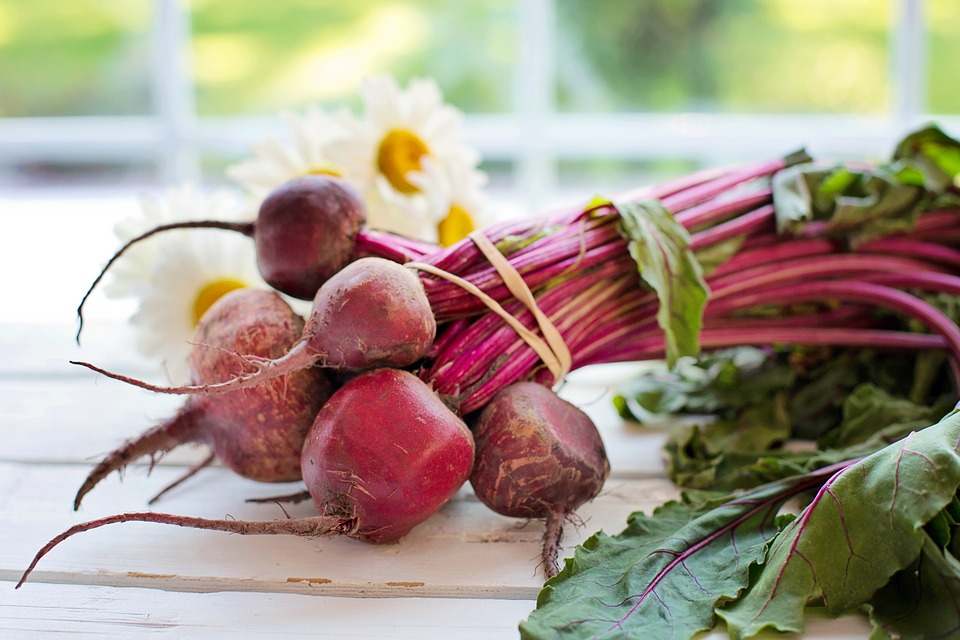Beetroot is in season from July through to October. It is not just the root that can be eaten but the leaves as well. You can eat beetroot raw blended in a juice or grated into salads and coleslaws. Beetroot is also delicious roasted in the oven, steamed or in soups.

It is a highly nutritious vegetable containing plenty of vitamins and minerals and a useful addition to your dietary intake. Here are some of the key nutrients:
- Folate, Manganese, Nitrates
- Magnesium, Potassium, Iron
- Vitamin C, Zinc, Bioflavonoids
- Betaine, Betalaine
Health benefits
Beetroot contains betalaines which give it its red colour and have antioxidant and anti-inflammatory properties. There is some evidence that nitrates in beetroot may help with cell respiration. This is the rate at which cells converts biochemical energy from nutrients into energy that the body can use for its processes.
Nitrates may also improve the rate at which the body’s tissues receive oxygen. Here, the nitrates in beetroot are converted into nitric oxide in the body which may help to dilate the blood vessels and increase the blood flow. This could potentially help to maintain the health of the heart, blood vessels and nervous system.
Beetroot could possibly help to improve inflammatory conditions such as skin disorders and arthritis caused by an over active immune system. Beetroot contains fibre and there is a link between high fibre diets and reduced risk of heart disease, colon cancer and type 2 diabetes. Fibre adds bulk to the stool and helps to reduce the risk of constipation and diverticulitis. The fibre it contains aids digestive function and provides food for the gut microbiome which help to maintain a healthy gut lining and ensure that nutrients are properly absorbed. When the gut wall is not properly maintained larger particles can be allowed to pass through to the blood stream and trigger an immune response.
I am sure that many people have heard of glycaemic index (GI). This is the amount of glucose that is contained in 100g of a carbohydrate containing food and beetroot has a medium GI of around 6. This might sound quite high to some but it has a low glycaemic load (GL) of around 2.9. The is because the rate that it releases sugar into the blood stream is slow. This is useful for people such as diabetics and pre-diabetics who are trying to keep their blood sugar levels balanced.
The amino acid betaine, found in beetroot, may also help to improve liver function.
There are some obvious side effects of eating beetroot. The red pigment may cause red faeces and urine. So don’t panic!
Is it for everyone?
The leaves of the plant are high in oxalates which can cause joint inflammation and so should be avoided by arthritis sufferers. The oxalic acid can also cause kidney stones and so the leaves should be avoided by people suffering from kidney disease.
Supplements instead?
Research is ongoing into supplementing the compounds found in beetroot for their health benefits. Many of the compounds have been studied individually but the greatest advantage could come from them all working together. Hence there is a benefit from eating the whole food but it should be noted that this is reliant on the body absorbing and processing the nutrients effectively.
If you suffer from any health condition or are taking any medications but would like guidance on how to increase your nutrient intake, then please consult with myself (Contact me) or other health care professional before changing your diet.
We all have different dietary requirements and need different types and amounts of nutrients to suit our lifestyles and health. This can be addressed through nutritional therapy. If you would like advice on the best nutrient dense diet for you then please feel free to contact me for a free 20-minute consultation to find out if this is for you.
0 Comments